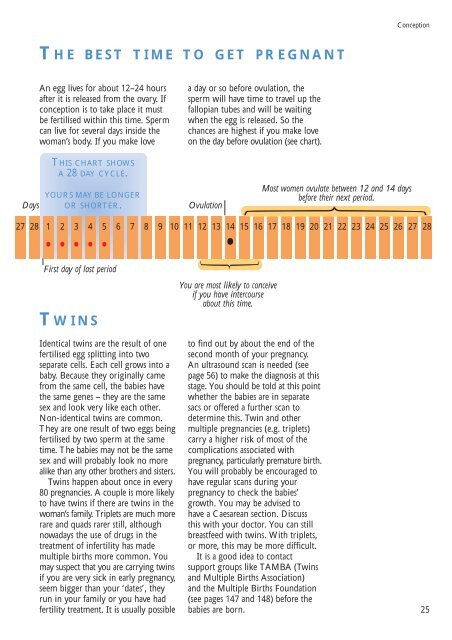here - Health Promotion Agency
here - Health Promotion Agency
here - Health Promotion Agency
Create successful ePaper yourself
Turn your PDF publications into a flip-book with our unique Google optimized e-Paper software.
Conception<br />
T HE BEST TIME TO GET PREGNANT<br />
An egg lives for about 12–24 hours<br />
after it is released from the ovary. If<br />
conception is to take place it must<br />
be fertilised within this time. Sperm<br />
can live for several days inside the<br />
woman’s body. If you make love<br />
a day or so before ovulation, the<br />
sperm will have time to travel up the<br />
fallopian tubes and will be waiting<br />
when the egg is released. So the<br />
chances are highest if you make love<br />
on the day before ovulation (see chart).<br />
THIS CHART SHOWS<br />
A 28 DAY CYCLE.<br />
Days<br />
YOURS MAY BE LONGER<br />
OR SHORTER.<br />
Ovulation<br />
Most women ovulate between 12 and 14 days<br />
before their next period.<br />
27 28 1<br />
•<br />
2<br />
•<br />
3<br />
•<br />
4<br />
•<br />
5<br />
•<br />
6 7 8 9 10 11 12 13 14<br />
•<br />
15<br />
16 17 18 19 20 21 22 23 24 25 26 27 28<br />
First day of last period<br />
T WINS<br />
Identical twins are the result of one<br />
fertilised egg splitting into two<br />
separate cells. Each cell grows into a<br />
baby. Because they originally came<br />
from the same cell, the babies have<br />
the same genes – they are the same<br />
sex and look very like each other.<br />
Non-identical twins are common.<br />
They are one result of two eggs being<br />
fertilised by two sperm at the same<br />
time. The babies may not be the same<br />
sex and will probably look no more<br />
alike than any other brothers and sisters.<br />
Twins happen about once in every<br />
80 pregnancies. A couple is more likely<br />
to have twins if t<strong>here</strong> are twins in the<br />
woman’s family. Triplets are much more<br />
rare and quads rarer still, although<br />
nowadays the use of drugs in the<br />
treatment of infertility has made<br />
multiple births more common. You<br />
may suspect that you are carrying twins<br />
if you are very sick in early pregnancy,<br />
seem bigger than your ‘dates’, they<br />
run in your family or you have had<br />
fertility treatment. It is usually possible<br />
You are most likely to conceive<br />
if you have intercourse<br />
about this time.<br />
to find out by about the end of the<br />
second month of your pregnancy.<br />
An ultrasound scan is needed (see<br />
page 56) to make the diagnosis at this<br />
stage. You should be told at this point<br />
whether the babies are in separate<br />
sacs or offered a further scan to<br />
determine this. Twin and other<br />
multiple pregnancies (e.g. triplets)<br />
carry a higher risk of most of the<br />
complications associated with<br />
pregnancy, particularly premature birth.<br />
You will probably be encouraged to<br />
have regular scans during your<br />
pregnancy to check the babies’<br />
growth. You may be advised to<br />
have a Caesarean section. Discuss<br />
this with your doctor. You can still<br />
breastfeed with twins. With triplets,<br />
or more, this may be more difficult.<br />
It is a good idea to contact<br />
support groups like TAMBA (Twins<br />
and Multiple Births Association)<br />
and the Multiple Births Foundation<br />
(see pages 147 and 148) before the<br />
babies are born.<br />
25

















